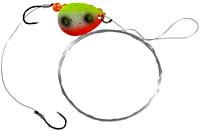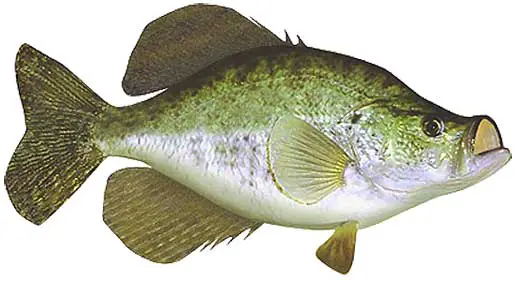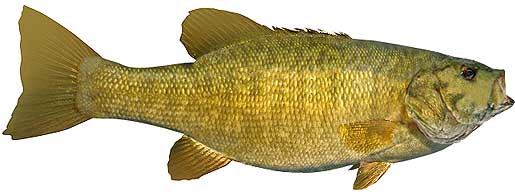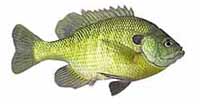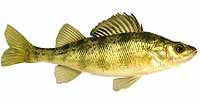Fishing Report For Keyhole Reservoir, WY
By Rick Seaman
Last updated on .

Fishing Reports
Popular Fish Species Keyhole Reservoir, WY
Walleye
Current Report: Fair To Good
FALL. Fall brought cooler temperatures to shallow water, drawing walleye and baitfish shallower. Walleye continue to be a major draw for anglers. Locals report catching nice walleye on long points, flats along the river and creek channels, and structure off shore. Jigs, swimbaits, spoons, crankbaits, jerkbaits, and spinnerbaits are all historically good for catching walleye this time of year. Early and late in the day finds them in 8 to 15 feet of water, mid day they hold 15 to 25 feet deep. Later in Fall, they move out slightly deeper. Dragging jigs, bottom bouncers, or worm harnesses with nightcrawlers or leeches, around ledge drop-offs is catching walleye fairly consistently. Watch for the bigger walleye to be slightly deeper than the majority of the school.
WINTER. This Winter, fishing for walleye has been pretty good through the ice, as it has been for the last few years. Before, during and after the ice, anglers report catching them in the main basin area, in 18 to 30 feet of water, along deep creek channel edges, rocky humps and ledges. Steep drops in the area toward the dam are also producing during these cold months. They primarily feed on small fish, staying close to the bottom. After ice-out blade baits, jigs, swimbaits, spoons, deep-diving crankbaits, and worm harness spinners, all work while deep trolling or drifting.
SPRING. Early Spring brings warming water in the shallows, and draws walleye here to feed, especially rocky areas and inlet channels. In Spring work points, drop offs, submerged structure, rock ledges, flats and flats adjacent to deeper water. Here, in 4 to 12 feet deep, they will spawn once the water warms to the mid to high 40's. When they move shallow, bright colored jigs, tipped with minnows or nightcrawlers typically catch them. Spinnerbaits, jerkbaits and crankbaits are also working when walleye are up shallow. Popular spawning areas include Pat’s Point, Cottonwood Bay, the mouths of small creeks along the southeast shore. Afterwards, they move to 12 to 20 feet deep around points, flats, shoals and ledges, nearby shore, often staying in close proximity to their spawning locations. Main lake drop offs are producing nice fish.
SUMMER. Water temperatures rise in Summer, and walleye fishing is good if you can get your bait deep enough. Early in Summer, walleye tend to concentrate in 8 to 15 feet of water. Throughout Summer, early in the morning, and from dusk to long after dark are good times to catch walleye. At those times they move slightly shallower to feed in low-light conditions. Night fishing is often good in Summer, as well. The rest of the time they are cruising flats and creek channel edges, 20 to 40 feet deep , preferring the cooler temperatures. When the bite is slow, grubs and nightcrawlers, fished just off the bottom typically catch walleye.
White Crappie
Current Report: Fair To Good
FALL. Baitfish, which moved into shallow flats, coves and bays, are are starting to migrate back to deeper water as the shallows cool. They are feeding heavily in preparation for the cold Winter, in 12 to 20 feet of water. Minnows, hair jigs, and crappie jigs, are good options during this feeding marathon. Late fall starts the migration deeper, toward winter holding areas, for both crappie and baitfish. Small flutter spoons, fished in 15 to 25 feet of water, are a good option during this transition. Ledge drop-offs in the 15 to 20-foot range, around Wind Creek, Pat’s Point, and Cottonwood Bay are producing good numbers.
WINTER. Once the shallows start cooling rapidly, crappie will migrate to deeper holding areas, mostly off shore. As the lake freezes over, crappie tend to hold in small schools around, or above, cover. Ice fishing is popular November through early May. At this time they are typically caught using a very slow presentation, in 15 to 30 feet of water. Most are caught around deep brush piles, creek channel bends, submerged timber, and main-lake structure. If they are suspending in open water, they often relate to some cover, or structure change, directly below them. During warming trends, especially warm afternoons, they may be drawn into 8 to 15 feet of water to feed.
SPRING. In early Spring, crappie begin staging in 3 to 12 feet of water, just outside spawning bays and shallow flats. Spring is prime time to be on the water, as crappie have moved shallow to spawn. At that time, they are typically caught in 2 to 8 feet of water. Vegetation, docks, brush and wood are where most anglers catch crappie using small crappie jigs or live minnows. After the spawn, crappie typically move outside the spawning area and hold on cover close by, in 12 to 15 feet of water. Once they move deep, anglers report success using fish finders and forward facing sonar to locate schools of crappie, which tend to stack vertically around cover. Light tackle, with 4 lb to 8 lb line, is a popular choice.
SUMMER. Water temperatures get quite warm, and crappie fishing is usually pretty good. They feed in 6 to 10 feet of water early and late in the day, until the hot Summer sun causes them to retreat to depths of 15 to 25 feet. Also, a few have embedded in the shade of slightly shallower vegetation. This is a good time to focus around brush piles, standing timber, deep lay downs and deeper docks. Anglers are also locating schools of crappie hanging over deep structure and around creek channel edges, using fish-finder electronics.
Smallmouth Bass
Current Report: Fair To Good
FALL. Fall is in full swing and smallmouth are following schools of baitfish back into deeper water. Most are being caught in 6 to 20 feet of water. They thrive in the cold, clean water, which is an ideal environment for them. Locals report that tube jigs are a great choice when the bass are around 15 feet deep. Drop shot rigs with small worms or shad shaped plastics are also popular in 10' water or deeper. Jerkbaits, deep-diving crankbaits, and slow-rolled spinnerbaits, are also successful, when bass are shallow to mid depth. Later in Fall, smallies move to slightly deeper water, around 10 to 25 feet deep. Fishing shallow for smallmouth is often good on cold, windy, cloudy and rainy days.
WINTER. Winter will isolate them around deeper structure, points, flats and creek channels, often suspending in open water above these features. Once the lake freezes over, ice fishing is quite popular, although mostly for other species. They can generally be found from 15 to 25 feet deep. Jigging spoons, tube baits, drop-shot worms, jigs and Ned rigs tend to temp smallmouth in deep water. I like to work these deeper haunts very slowly, as the bass are somewhat sluggish. Here they hold, feeding less frequently, awaiting warmer water to return in Spring.
SPRING. After ice out, when water temperatures rise into the 50's, smallmouth move from deep wintering spots to shallower water, just outside spawning areas. They feed heavily in 3 to 12 feet of water at this time, and are typically caught on jerkbaits, crankbaits, tube baits, Ned rigs, and crayfish imitating plastics. Popular areas include Pat’s Point, Cottonwood Bay, the mouths of creeks on the southeast shore. Once water warms into the high 50's, they move into shallower water, and create nests in gravel or sand areas, then lay their eggs. Females then move to deeper water and males remain to guard the eggs, and then the fry. After a couple weeks, the males also move into 15 to 20 feet deep, and feed aggressively. Crankbaits, tube baits, Ned rigs, plastic worms, spoons and swimbaits are catching smallies during this period.
SUMMER. Smallmouth bass are currently feeding shallow early and late in the day in 6 to 12 feet of water. They are being caught on topwater, crankbaits, swimbaits, Ned rigs and tube baits. Smallmouth bass here feed on crawfish, gizzard shad, and small sunfish. They prefer rocky or gravel bottom areas, as this is where crayfish live. During the hotter parts of the day, they are being caught on points, humps, and ledges 12 to 30 feet deep. Main-lake points, deep rock piles, and ledges are typical Summer haunts. Often these deeper fish tend to school, so finding them can deliver some fast action.
Fishing Video
Fish species to fish for...
Guide to fishing for smallmouth bass, channel catfish, black crappie, white crappie, walleye, bluegill, green sunfish, yellow perch and northern pike at Keyhole Reservoir in Wyoming.
 Keyhole Reservoir, aka Keyhole Lake, is a 9,300-acre lake with over 50 miles of shoreline,some with access for fishing from the bank. In winter, this is a great place for ice fishing. A marina, boat ramps, stores, campgrounds and restaurants are all handy at the lake.
Keyhole Reservoir, aka Keyhole Lake, is a 9,300-acre lake with over 50 miles of shoreline,some with access for fishing from the bank. In winter, this is a great place for ice fishing. A marina, boat ramps, stores, campgrounds and restaurants are all handy at the lake.
Primary fish species to catch
Click images for fishing tips and details about each species.
Today's Weather & Forecast
Fishing Boat Rentals
Click here for fishing boat rentals.
Public Boat Launch Ramps & Landings
Click here for boat ramps.
Marinas
Click here for marinas.
Fishing License
Click here for a Wyoming Fishing License.
Map - Fishing & Access
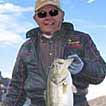 Rick Seaman is a fishing enthusiast with over five decades of fishing experience, a retired tournament fisherman, author of numerous published articles on fishing, and co-author of the book "Bass Fishing - It's not WHAT you throw, It's WHERE you throw it".
Rick Seaman is a fishing enthusiast with over five decades of fishing experience, a retired tournament fisherman, author of numerous published articles on fishing, and co-author of the book "Bass Fishing - It's not WHAT you throw, It's WHERE you throw it".
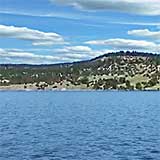 Contact Information
Contact Information
Keyhole Marina
180 Marina Rd
Pine Haven, WY 82721
307 756-9529
Fishing lakes in each state
110825
Keyhole Reservoir, Wyoming Report
WYOMING


Information about fishing lakes in Wyoming
Keyhole Reservoir offers bass, catfish, crappie, walleye, bluegill, perch, sunfish and northern pike fishing in northeast WY.



